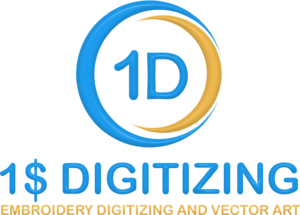A great embroidered hoodie is special. It’s not just clothes. It’s a moving ad for your brand. It builds team spirit. Or maybe it’s a cool custom gift. This guide shows you the whole process. We’ll turn your digital logo into a sharp, tough design. Something that really gets noticed.
Embroidery just has a certain flair. It’s classier than screen printing. It feels more expensive. And it lasts through so many washes. You get a premium vibe that printing can’t touch.
Are you a business owner? Want to outfit your crew? Or a designer with a new clothing line? Maybe you just want a one-of-a-kind hoodie. Learning this process is super important. We’ll cover it all. From getting your design right. To picking the best fabric. And we’ll dive into digitizing. It’s the most crucial part.
Understanding the Embroidery Process from Start to Finish
So, how do you make a custom hoodie? It all happens in a few main stages. You start with just an idea. You end with a real, top-quality product. Knowing this workflow helps you make smart choices. You can dodge common mistakes. And you’ll get that professional look. Each step is a building block. Getting the first parts right is everything.
Step 1: Finalizing Your Design Concept
Okay, hold on. Before you think about threads. Your design needs to be embroidery-ready. A logo can look awesome on screen. But it might not stitch out well. It’s a totally different medium.
Here are some things to consider.
- Keep It Simple: Tiny details are a problem. So are super small letters. Complex color gradients? Also, tough. Clean lines are your best friend. Bold shapes always look better. You might need a simpler logo version. Just for your embroidery projects.
- Pick Your Colors: Embroidery machines use spools of thread. Each thread is a specific color. You need to match your logo colors. Find the closest thread shades. Using fewer colors can help. It makes things less complex. It can also save you some money.
- Size and Placement Matter: Where is the logo going? A small crest on the chest is popular. It has different needs than a big back graphic. Measure the spot on the actual hoodie. Then, scale your design to fit. A typical chest logo is about 3 to 4 inches wide. That’s a good starting point.
Step 2: The Critical Role of Embroidery Digitizing
This part is where the real magic is. Your regular image file won’t work. A JPEG or PNG means nothing to an embroidery machine. The design has to be converted. It needs to be a special stitch file. Think. DST or. PES formats. This whole conversion thing is called digitizing.
It’s not some automated, quick process. Don’t let anyone tell you it is. Digitizing is a true art form. It’s done by a skilled person. A digitizer uses special software. They map out every single stitch. They decide the stitch types. And the direction of the stitches. They figure out the density. They plan the entire stitch sequence. This is how your logo gets recreated. Perfectly, with thread.
A good digitizer also thinks about the fabric. This helps prevent ugly puckering. Or the design getting distorted. The quality of this digitized file is huge. It’s the most important factor. It determines your final result.
Step 3: Finding the Best Embroidery Digitizing Services
You probably aren’t a pro digitizer. So, you’ll need to hire one. Going with cheap, bad digitizing is a disaster. It leads to awful results. You’ll see gaps in the stitches. Things won’t line up right. The whole design will look amateur. That’s why you need a partner. Finding the best embroidery digitizing services is a must. It’s not a step you can afford to skip. Not if you want a professional look.
What should you look for?
- Check Their Work: Look at their portfolio. Do their samples have clean lines? Is the text sharp and readable? Do they handle different fabrics well? Have they worked on designs like yours?
- Ask About Turnaround: How fast can you get the file? Many services in the USA and UK offer quick turnarounds. Sometimes in just 24 hours. But be careful. Rushing can sometimes affect quality.
- Talk to Them: Good digitizers offer support. They should be willing to make changes. They should give you advice. They can explain why they made certain choices. About stitch types and the pathing.
- Get the Right File: Make sure they can export the file you need. It has to match your embroidery machine. Or the format your production partner uses.
Step 4: Choosing the Right Hoodie
The hoodie is your canvas. It’s where your art will live. The material matters a lot. So does the weight and the fabric blend. These things totally change the final look. They also affect how the embroidery feels.
- Fabric Makeup: Cotton and polyester blends are super popular. They create a stable surface. This is great for embroidery. They also don’t shrink as much. Plus, they are comfortable to wear. 100% cotton is really soft. But it can be less stable for stitching. Fleece and other fluffy fabrics are tricky. They need special techniques. Otherwise, stitches just sink into the fabric.
- Fabric Weight: This is measured in GSM or ounces. It tells you how thick the hoodie is. A heavier hoodie is better. Especially for dense embroidery. It gives a stable base. It helps stop puckering. Lighter hoodies are fine for smaller logos. Or less complex designs.
- Color Choice: Pick a hoodie color that works with your logo. You want your thread colors to look good. High contrast makes a logo stand out. A more tonal color scheme is subtle. It gives a very sophisticated look.
Step 5: Production and Quality Control
You have your digitized file. You have your hoodie. Now it’s time to make it. This means hooping the garment. Then loading the design. And running a test stitch-out.
You must always ask for a sample. Get a test stitch on a similar fabric. Do this before making the whole batch. This lets you check for important things.
- Stitch Quality: Are the stitches neat? Are they consistent and tight?
- Color Accuracy: Do the threads look right? Do they match what you picked out?
- Detail Clarity: Can you read the text? Are the small details easy to see?
Once you say the sample is good? The full production can start.
How to Get the Most from Custom Embroidery Services
Lots of people work with a production partner. Especially if they don’t own a big machine. When you use custom embroidery services, you trust them. You trust their gear and their skills. They are the ones who will bring your vision to life.
You need to give them clear directions. This makes the whole process smoother. A pro service will help you. But being prepared saves a lot of time. It also prevents costly mistakes. Make a simple “tech pack.” It’s just a document with key info.
- The Digitized File: Send the final stitch file. The one from your expert digitizer.
- Design Placement: Show them where the logo goes. A visual mock-up is perfect. For example: “Left chest. 4 inches from the collar.”
- Thread Colors: Give them specific thread color codes. Use Pantone, Madeira, or Isacord codes. This ensures a perfect match.
- Garment Details: List the hoodie brand. And the style number. Also, the color and sizes you need.
Clear communication is everything. It helps your embroidery partner get it right.
Pro Tips for Flawless Embroidered Hoodies
Getting a good result is one thing. Getting a truly great result is another. It’s all about the small details. Here are some tips from the experts. They will help you level up your apparel.
- Simplify That Logo: Not every logo is made for embroidery. Get rid of thin lines. And tiny text smaller than 4mm is risky. Forget about smooth gradients. A simpler, bolder logo will stitch out cleaner. It will always look more professional.
- Get Great Digitizing: Never, ever cheap out on this step. Auto-digitizing software is a bad idea. So is an inexperienced provider. It’s the quickest way to ruin good hoodies. A quality file from one of the best embroidery digitizing services is key.
- Think About the Fabric: A file for a t-shirt won’t work on a thick hoodie. Your digitizer needs to know the fabric. They must add an “underlay.” This is a base layer of stitches. It stabilizes the fabric. It stops the top stitches from sinking in. Always tell your digitizer what you’re using.
- Choose Threads Carefully: Look at thread charts in natural light. A color on your screen can look very different. For official brand colors, use Pantone conversion charts. This gets you the closest possible match.
- Test, Test, and Test Again: Before you sew on the real hoodies. Always run a stitch-out. Use a scrap piece of the same fabric. This is your last chance. You can catch errors in the file. Or the color. Or the size.
- Placement Is Everything: The classic left-chest logo is a winner. It’s visible and looks professional. Want a more modern vibe? Try the sleeve. Or the hoodie’s front pouch. The upper back is another cool spot. Use a ruler. Make sure your placement is the same on every single garment.
Bring Your Vision to Life
Making custom embroidered hoodies is so rewarding. It blends new tech with old craft. Focus on a strong design. Invest in professional digitizing. Choose the right garments. If you do that, you can make apparel that looks amazing. And it will last for a very long time. The secret is to handle each step with care. From your first idea to the very last stitch.
Ready to get started on your project? You need a flawless digital file. One that makes your apparel stand out. Consider a trusted partner like 1dollardigitizing. They can handle all your design-to-stitch file needs.




